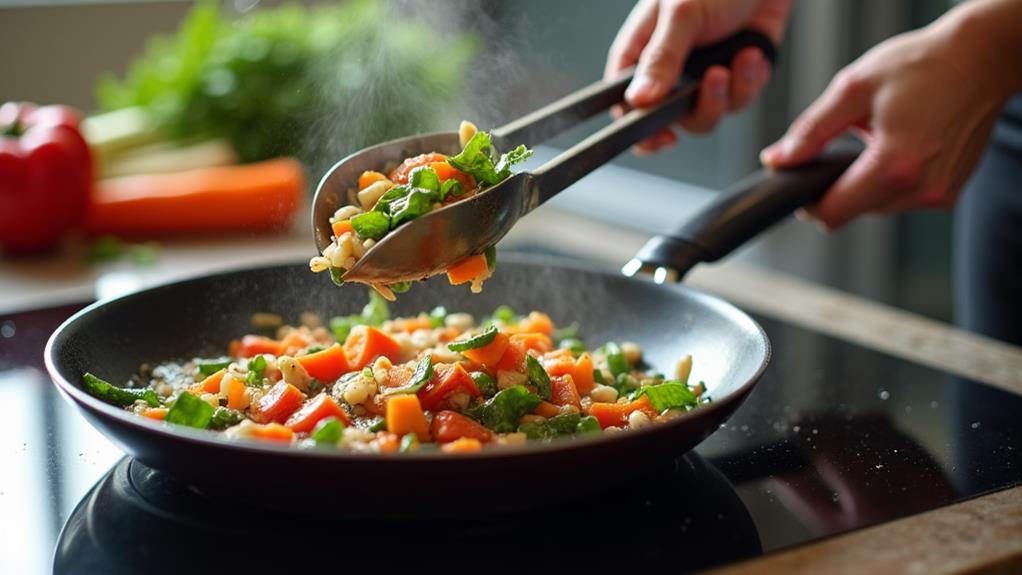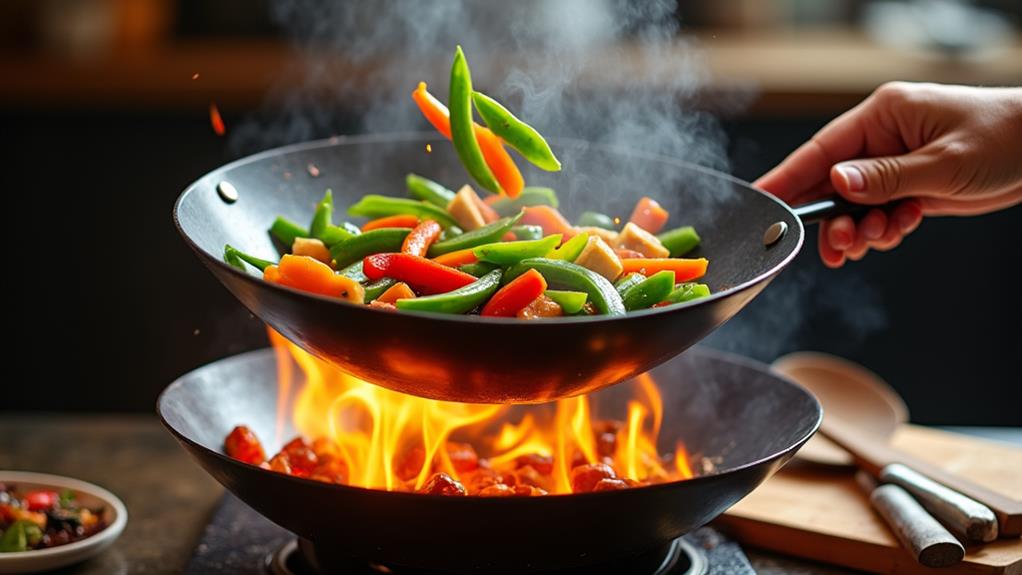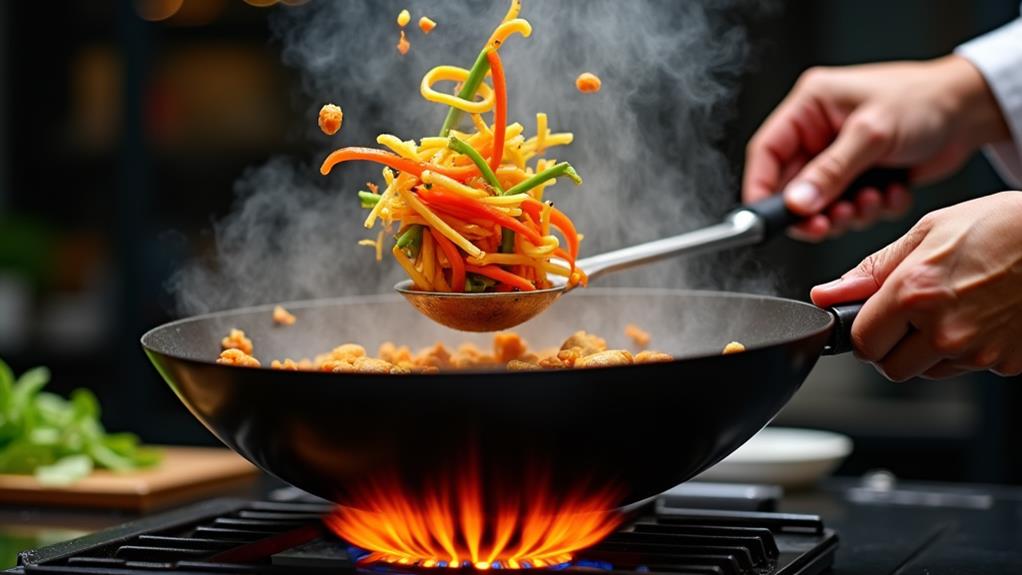Sautéing can trip you up due to several common pitfalls. You might start with a cold pan, leading to steaming instead of searing, or overcrowd the pan, hindering proper browning. Poorly prepped ingredients and mistimed additions can result in uneven cooking. Choosing the wrong oil affects flavor and cooking performance, while excess moisture ruins crispy textures. Overzealous stirring prevents caramelization, and temperature control troubles can lead to under or overcooked food. Neglecting finishing touches misses opportunities to elevate your dish. By understanding these potential missteps and their solutions, you'll be better equipped to master the art of sautéing and create restaurant-quality meals at home.
Cold Pan Syndrome
One of the most common mistakes home cooks make when sautéing is falling victim to cold pan syndrome. This cooking technique pitfall occurs when you add ingredients to a pan that hasn't reached the proper temperature. The result? Instead of achieving that coveted golden-brown sear, your food ends up steaming and sticking to the surface.
To revolutionize your sautéing game, start by preheating your pan over medium-high heat for a few minutes. Test the pan temperature by sprinkling a few drops of water onto the surface. If they sizzle and evaporate quickly, you're ready to go.
Next, add your oil and let it heat for about 30 seconds before introducing your ingredients. This extra step ensures that the oil is hot enough to create a barrier between the food and the pan, preventing sticking and promoting even cooking.
Choosing the Wrong Oil
While preheating your pan is key, selecting the right oil is equally important for successful sautéing. Your oil choice can make or break your dish, affecting both flavor and cooking performance.
When it comes to oil selection, consider the smoke point and flavor profiles of different oils. For high-heat sautéing, opt for oils with high smoke points like avocado, grapeseed, or refined coconut oil. These oils can withstand higher temperatures without breaking down and imparting unwanted flavors.
However, don't overlook the impact of oil on your dish's taste. Some oils, like extra virgin olive oil or sesame oil, have distinct flavors that can complement or clash with your ingredients. For neutral-tasting dishes, choose oils with mild flavor profiles such as canola or vegetable oil.
Poorly Prepped Ingredients
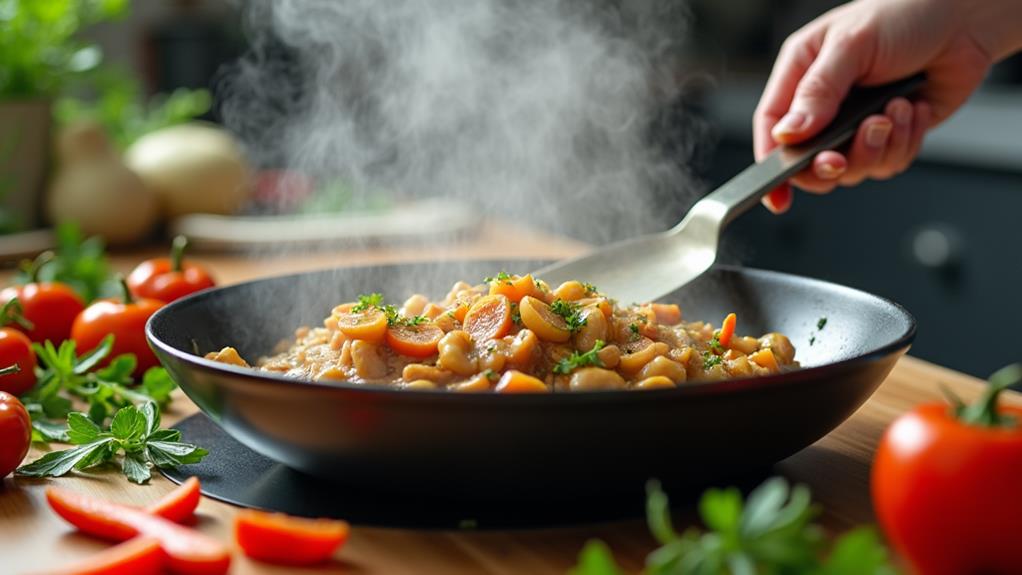
Preparation is the foundation of successful sautéing. When you dive into the pan without properly prepping your ingredients, you're setting yourself up for disappointment. Ingredient uniformity is key; inconsistent sizes lead to uneven cooking, with some pieces burning while others remain undercooked.
For example, in dishes like Butternut Squash Mac and Cheese, ensuring that all ingredients are cut uniformly helps achieve a creamy sauce and perfectly cooked pasta. To achieve optimal results, master essential preparation techniques like julienning, dicing, and mincing.
Start by sharpening your knives – dull blades crush cells, leading to moisture loss and compromised texture. Next, focus on creating uniform pieces. For vegetables, aim for similar sizes to ensure even cooking. When working with meat, trim excess fat and slice against the grain for tenderness.
Don't forget to pat ingredients dry; excess moisture hinders proper browning and can lead to steaming instead of sautéing. Consider the order of addition based on cooking times. Dense vegetables like carrots should enter the pan before quick-cooking items like spinach.
Overcrowded Cooking Space
With your ingredients prepped and ready, it's time to consider your cooking space. Overcrowding your pan is a common mistake that can derail your sautéing efforts. When you crowd too many ingredients into a small pan, you'll end up steaming rather than sautéing, resulting in soggy, unevenly cooked food.
To avoid this pitfall, choose a pan size that's appropriate for the amount of food you're cooking. As a rule of thumb, your ingredients should cover no more than two-thirds of the pan's surface. This allows for proper heat distribution and ensures each piece of food has enough space to cook evenly.
Pay attention to ingredient ratios as well; if you're sautéing a mix of vegetables, for instance, cut them into similar sizes to promote uniform cooking.
If you find yourself with more ingredients than your pan can handle, consider cooking in batches. While this may take a bit more time, it'll yield far superior results.
Mistimed Ingredient Additions
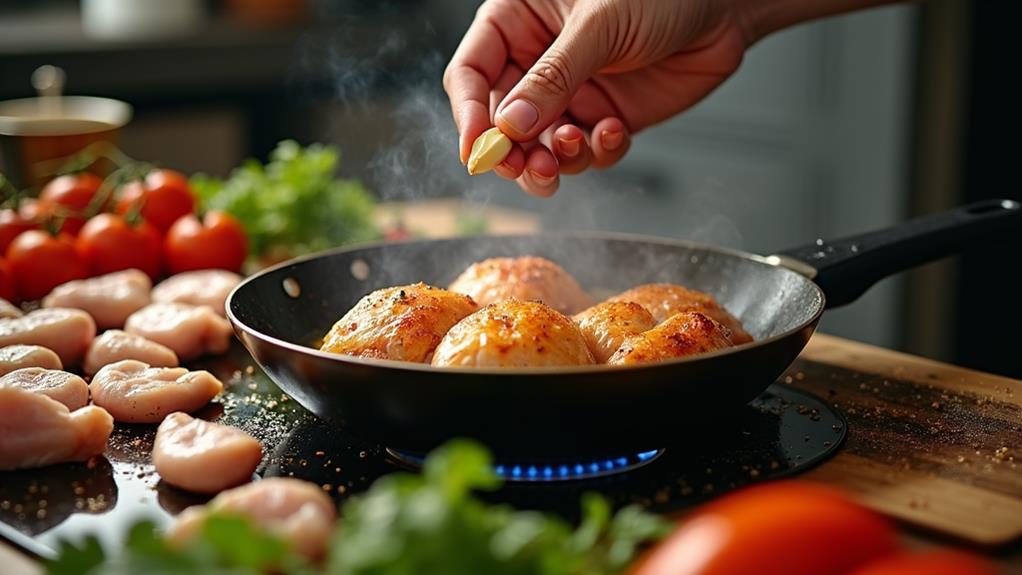
When sautéing, you'll need to master the art of timing your ingredient additions to achieve the best results.
For example, when preparing Slow Cooker Chili Con Carne, browning the ground beef beforehand is essential for enhancing flavor.
Overcrowding the pan can lead to uneven cooking and steaming instead of browning, so it's crucial to add ingredients in batches if necessary.
Additionally, maintaining proper temperature control throughout the cooking process ensures that each ingredient is cooked to perfection, allowing you to create dishes with optimal flavor and texture.
Overcrowding the Pan
Eager to achieve perfectly sautéed dishes, many home cooks make the mistake of overcrowding the pan. This common error can significantly impact cooking efficiency and compromise the quality of your meal.
When you exceed the pan capacity, you risk steaming your ingredients instead of sautéing them, resulting in soggy, unevenly cooked food.
To avoid this culinary pitfall, consider these key points:
- Respect your pan's size and cook in batches if necessary
- Leave ample space between ingredients for proper browning
- Ensure each piece makes direct contact with the hot pan surface
- Resist the urge to stir constantly, allowing food to develop a golden crust
- Monitor heat levels to prevent burning while maintaining a sizzle
Improper Temperature Control
Another common sautéing mistake is improper temperature control, particularly when it comes to adding ingredients at the wrong time. You might think throwing everything into the pan at once saves time, but it's a recipe for disaster. Different ingredients require varying cooking times and temperatures, so timing is crucial for optimal results.
To master sautéing, you need to understand heat distribution and temperature calibration. Start by preheating your pan over medium-high heat, then add oil and wait until it shimmers.
Begin with ingredients that take longer to cook, like onions or carrots, before introducing quicker-cooking items such as garlic or leafy greens. This staged approach ensures each component reaches its ideal texture and flavor.
Pay attention to your pan's temperature throughout the cooking process. If it's too hot, ingredients will burn; too cool, and they'll steam instead of sauté. Adjust the heat as needed, and don't be afraid to temporarily remove the pan from the burner if things are cooking too quickly.
Moisture Management Mishaps
When sautéing, you'll want to keep a close eye on moisture levels to achieve the perfect texture and flavor. Excess water in your pan can quickly turn crispy foods soggy, so it's crucial to pat ingredients dry before adding them to the hot oil.
Additionally, overcrowding your pan will lead to unwanted steam buildup, preventing that coveted golden-brown sear, so be sure to give your ingredients plenty of space to cook properly.
Excess Water Ruins Crispiness
Beware the silent saboteur of crispy sautés: excess water. When you're aiming for that perfect crisp texture, water absorption becomes your nemesis. Ingredients naturally contain moisture, and if not managed properly, it can spell disaster for your dish.
To combat this culinary foe, consider these innovative strategies:
- Pat dry ingredients thoroughly before cooking
- Use a hot pan to quickly evaporate moisture
- Avoid overcrowding the pan, which traps steam
- Add salt at the right moment to draw out excess water
- Employ high-heat cooking oils to create a moisture barrier
Crowding Causes Steam Buildup
Once you've mastered moisture control, you'll face another common sautéing pitfall: overcrowding the pan. When you add too many ingredients at once, you're not just reducing the cooking space; you're creating a steam trap. As the food releases moisture, it has nowhere to escape, leading to a buildup of steam that sabotages your efforts to achieve that perfect golden-brown sear.
To revolutionize your sautéing technique, embrace the concept of "breathing room." Give your ingredients space to release steam and allow for proper heat circulation. If you're working with larger quantities, consider cooking in batches. This approach might seem time-consuming, but it's a game-changer for achieving consistent results.
As you sauté, pay attention to the sounds coming from your pan. A gentle sizzle indicates ideal cooking conditions, while silence often signals overcrowding. Remember, innovative cooking techniques often involve rethinking conventional methods. By mastering steam release management, you'll elevate your sautéing skills, creating dishes with superior texture and flavor.
Don't be afraid to experiment with different pan sizes and ingredient quantities to find your optimal sautéing setup.
Overzealous Stirring
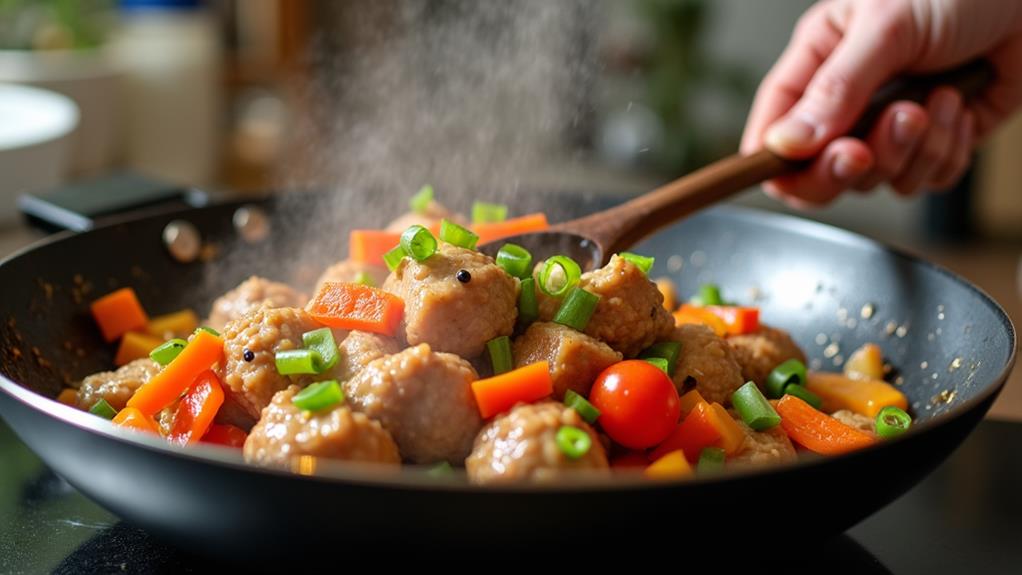
Excessive stirring can be the downfall of a perfectly good sauté. While you might think constant agitation is the key to even cooking, overzealous stirring techniques can actually hinder your culinary success.
To achieve optimal results, it's crucial to understand stirring frequency guidelines and resist the urge to continuously move your ingredients around the pan.
Here's why overzealous stirring can be detrimental:
- It prevents proper browning and caramelization
- It breaks down delicate ingredients
- It releases excess moisture, leading to steaming instead of sautéing
- It cools the pan, reducing the efficiency of the cooking process
- It can result in unevenly cooked food
To master the art of sautéing, you'll need to embrace a more hands-off approach. Allow your ingredients to develop a flavorful crust by letting them sit undisturbed for short periods.
When you do stir, use purposeful movements to redistribute the food and promote even cooking. By adopting these innovative techniques, you'll elevate your sautéing skills and create dishes with superior texture and taste.
Temperature Control Troubles
Many home cooks struggle with temperature control when sautéing, leading to less-than-ideal results. The key to mastering this technique lies in understanding how to manage heat distribution and minimize temperature fluctuations. To achieve consistent results, you'll need to become familiar with your stovetop's quirks and how different pans react to heat.
Start by preheating your pan over medium-high heat for a few minutes before adding oil. This ensures even heat distribution and prevents hot spots.
Once you've added your ingredients, resist the urge to constantly adjust the heat. Instead, listen to the sound of the food cooking and watch for visual cues. A gentle sizzle indicates the perfect temperature, while a loud sputtering suggests it's too hot.
If you notice temperature fluctuations, don't panic. Adjust the heat gradually and allow time for the pan to respond.
Remember, different ingredients require different cooking temperatures. Delicate items like fish benefit from lower heat, while heartier vegetables can withstand higher temperatures.
Neglecting the Finishing Touch
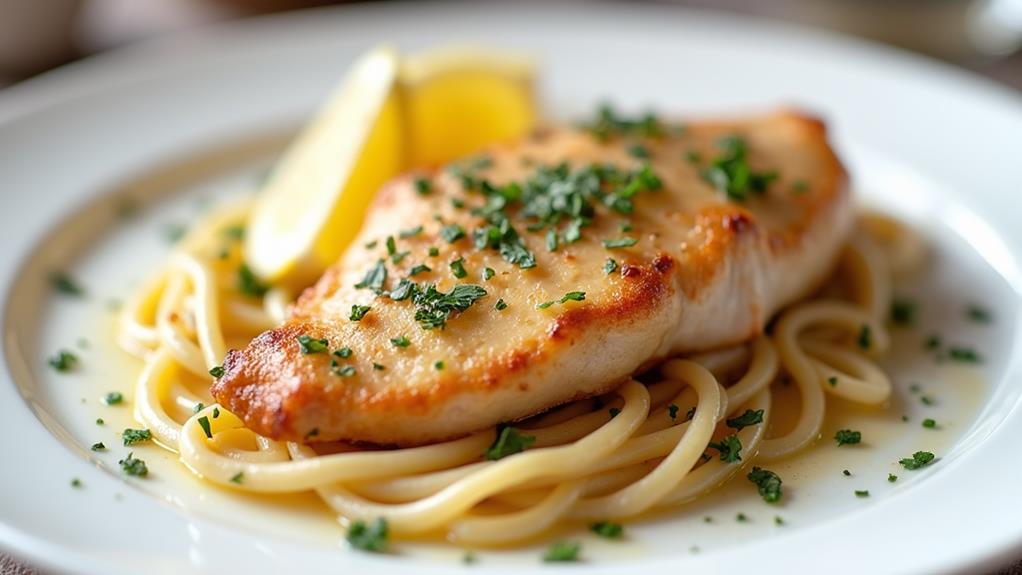
After perfecting your sautéing technique, it's easy to overlook the crucial finishing touch.
You've mastered the heat, conquered the flip, but now it's time to elevate your dish from good to extraordinary. Just as a balanced combination of flavors enhances a salad, like in the Watermelon Feta Salad With Mint, finishing techniques and plating presentation are the final steps that transform your sautéed creation into a masterpiece.
Don't let your hard work go to waste by neglecting these essential elements. Here are five innovative ways to add that perfect finishing touch:
- Drizzle a flavored oil or reduction sauce for a burst of color and taste
- Sprinkle fresh herbs or microgreens for a pop of freshness and texture
- Add a crispy element, like toasted nuts or seeds, for contrasting crunch
- Incorporate a creamy component, such as a dollop of flavored butter or aioli
- Finish with a dusting of specialty salt or spice blend for depth of flavor
Frequently Asked Questions
How Do I Choose the Right Pan for Sautéing?
When selecting a sauté pan, prioritize innovative materials that excel in heat distribution. You'll want a pan that's responsive to temperature changes. Opt for stainless steel or copper for their superior conductivity and even heating properties.
Can I Sauté Frozen Vegetables?
Imagine you're a frozen veggie explorer! You can sauté them, but first, embark on a thawing adventure. Innovative sautéing techniques await: pat dry, crank up the heat, and watch your frozen friends transform into crisp, flavorful morsels.
What's the Difference Between Sautéing and Stir-Frying?
You'll find sautéing techniques focus on flavor development with less movement. Stir-frying, however, keeps ingredients in constant motion. Both use high heat, but sautéing typically involves smaller batches and longer cooking times for deeper flavors.
How Long Should I Sauté Meat Before Adding Vegetables?
You'll want to sauté meat first for optimal tenderness. Aim for 3-5 minutes per side, depending on thickness. Once it's browned, remove it and set aside. Then, cook your veggies separately, adjusting cooking times for each.
Is It Necessary to Use a Lid When Sautéing?
You don't need a lid when sautéing. It's actually counterproductive to the technique's goal of browning and crisping. However, if you're aiming for moisture retention, a lid's benefits can be leveraged in certain innovative fusion techniques.
Final Thoughts
As you navigate the culinary minefield of sautéing, remember that mastery comes through practice. Like a tightrope walker balancing delicately above the crowd, you'll learn to juggle heat, timing, and ingredients with finesse. By avoiding common pitfalls and honing your techniques, you'll transform from a novice to a skilled chef. Embrace the learning process, and soon you'll be creating perfectly sautéed dishes that'll impress even the most discerning palates. The kitchen is your stage; make it shine.

